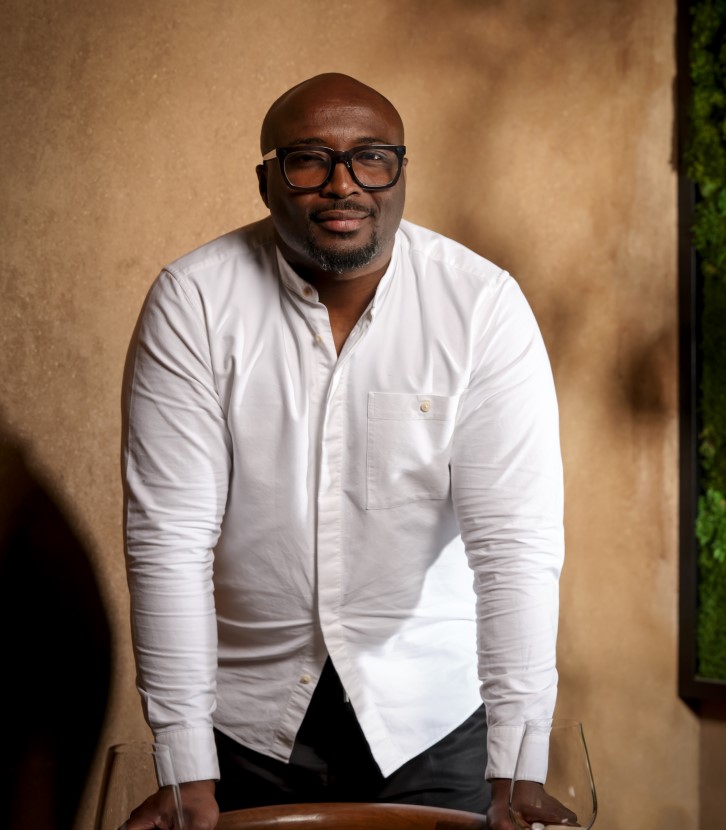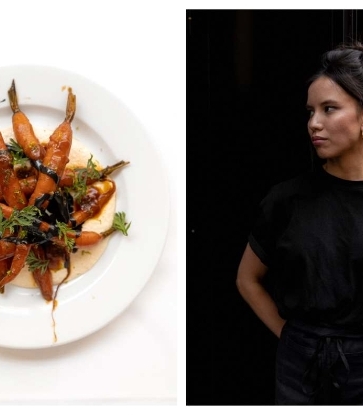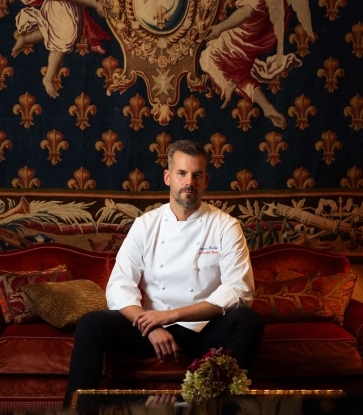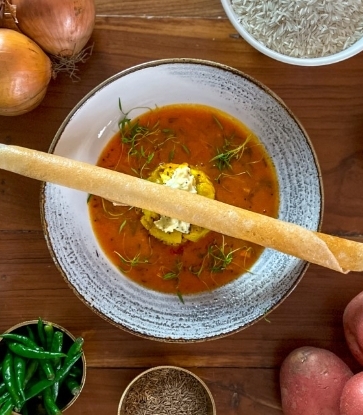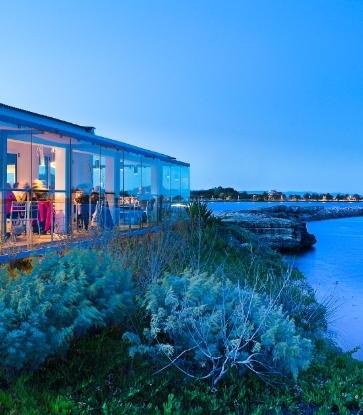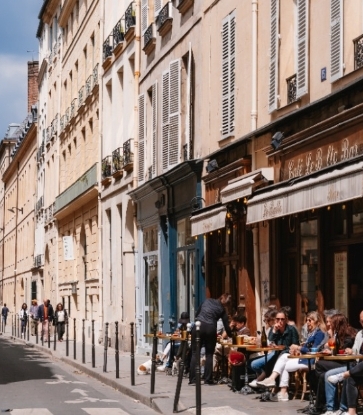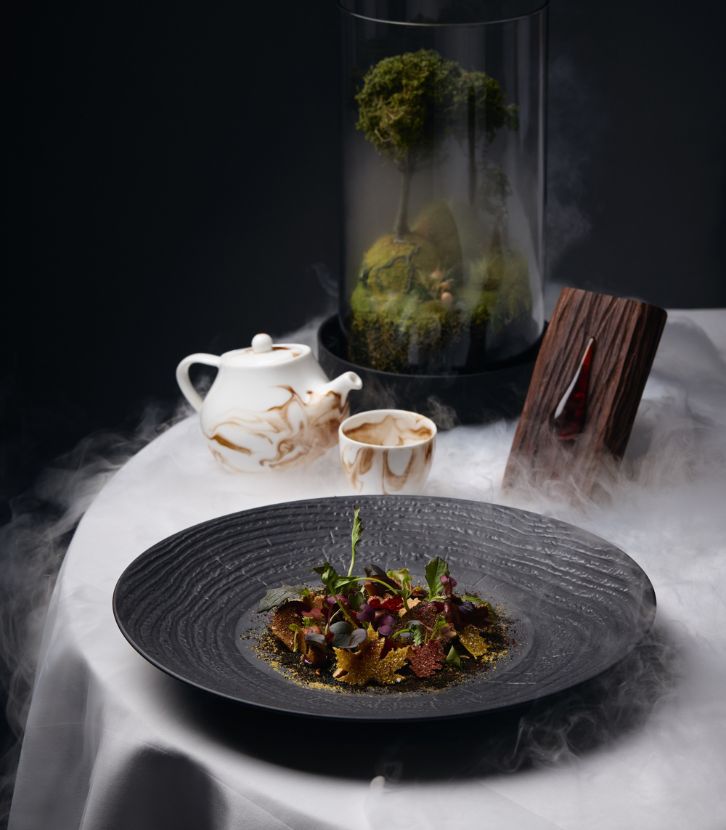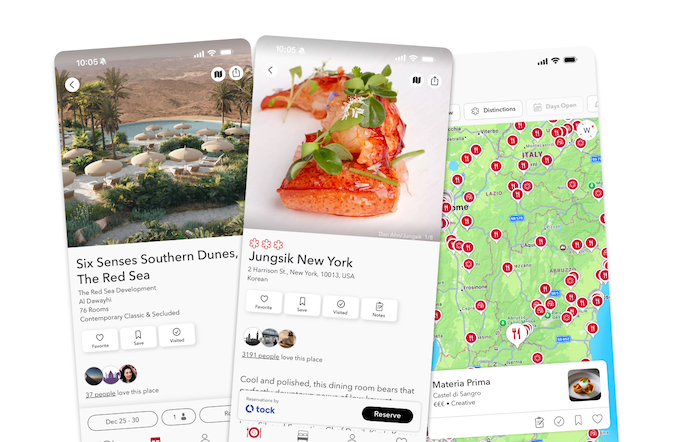In his own words, cooking saved Cachot. He struggled in school and faced personal setbacks, but his life changed at 14, when Chef Nicolas Magie took him under his wing at La Cape, a MICHELIN-Starred restaurant in Cenon, near Bordeaux. Cachot followed Magie to the legendary Saint-James in Bouliac, an architectural gem designed by Jean Nouvel. Later, in Paris, he crossed paths with Chef Christian Etchebest, the pioneer of Parisian bistronomy and the force behind La Cantine du Troquet.

As this interview reveals, his talent is rooted in a childhood rediscovered — and finally nurtured.
If you were a color?
Black. I know it’s not technically a color — but still, black.If you were a kitchen utensil?
A knife. It saved my life.It represents craftsmanship from beginning to end. You need it, you have to care for it, you learn to love it. And it was made with love in the first place. Every knife tells a story. I especially love the knives from Atelier Doma — they work with Japanese artisans. Beautiful pieces. We spend our days with knives. I’m very attached to mine.
If you were an animal?
A wolf. It’s beautiful, wild, inspiring.If you were a spice?
Chile. It’s a flavor I’ve grown to love. I’ve been eating chile for 15, 20 years — and the more I’ve learned to eat it, the more I’ve loved it. It makes you think. Chile peppers, they fascinate me.I was trained 20 years ago at La Cape in Cenon, near my hometown outside Bordeaux. Next to the restaurant was a shop that sold Asian, Korean and Thai ingredients — it became part of my education. One of my childhood best friends is Vietnamese. My wife is French-Japanese. After my first restaurant closed, I spent three years traveling the world, especially Asia. These days I eat mostly Asian food, at home and when I go out.
If you were a tree?
A pine tree. We have a lot of pine trees where I’m from — the southwest — and I’ve always loved pine trees.If you were a cooking technique?
Heat. Because you can have the best product, but if the cooking’s off, it’s ruined. You have to master it. Be precise.If you were a dish?
Fideuà. It connects me to my Catalan roots and my maternal family in Barcelona. We’d eat it in the summer. It’s simple: just vermicelli noodles in fish broth. Pure pleasure. If you were a scent?
Rum. 
If you were a market?
Tsukiji in Tokyo, the now-closed fish market. And second, Kii-Katsuura tuna market in southern Japan. A vast hangar facing the sea, filled with fish of every size and species. Visually stunning.If you were an emotion?
Tenderness. I like that. Being moved — by a word, a gesture, a dish.What’s hard is that I have lots of ideas, too many desires. At Vaisseau, I’ve learned to slow down, to focus. My job is to find the best technique, the perfect temperature, to express the most sensitivity. Even a sauce or seasoning — it’s all tasted and refined. There’s tenderness in everything we do, even if people are sometimes surprised by the boldness of the flavors. We’re after emotion, not explanation.
If you were a season?
Spring. When everything turns green again, it’s amazing. Asparagus, peas — green things lift my spirits.If you were a country?
France.If you were a food and wine pairing?
Vin jaune [a type of white wine made in the Jura region in eastern France] and tripe.
If you were a pepper?
Penja pepper from Cameroon. Chef Pierre Siewe, from Table de Penja in Paris, brings us green and white pepper straight from Cameroon. They’re exceptional.If you were a music style?
French rap from the '90s. Groups like IAM, NTM — my youth.If you were a song?
365 Jours by rapper Oxmo Puccino.If you were a terroir?
The southwest, where I grew up. Through this restaurant, I’ve reconnected with my roots and my family story. The duck is from the southwest; so is the chicken. The fish comes from the French coast. I’m happy when I get a beautiful hake from the Saint-Jean-de-Luz market.It’s a return to my training and my memories. The older I get, the more I’m drawn to that land, the more I realize how lucky we are here in France. And we don’t even realize it.
If you were a city?
Tokyo. I went for the first time 10 years ago. It was a total shock — the lifestyle, especially the everyday food. Coming from a modest background, I thought I understood popular cuisine. But in Tokyo, people eat all day for less than a euro. I had lunch at a MICHELIN-Starred place that only cooks sardines — 8 euros for a full menu. They cook everything with love, even humble ingredients.In France, we often dismiss an ingredient if it isn’t pretty. Over there, they find a way to make it shine. We still don’t fully grasp how essential food, wine and gastronomy are here. We’ve got work to do — especially around quality. I was talking to Alain Ducasse about this just recently.

If you were a type of meat?
That’s a tough one. I love duck because you can use every part of it. But I’ll say Wagyu beef from my friend Ludovic Follet in Normandy. He takes his time, cares for the animals and lets them mature when we ask.If you were a negative trait?
Betrayal. It disgusts me far more than cruelty.If you were a type of offal?
Funny, I was just thinking about this last week. Maybe sweetbread, aged a bit. You let it air out at a controlled temperature for three to four days. It loses some moisture and crisps up beautifully when cooked. We discovered this by accident — thanks to a mistake.If you were a movie?
Jurassic Park. It’s not the greatest movie ever made, I know, but it left a mark on me. It represents my childhood. I’ve always been a bit of a dreamer. That film helped me escape, imagine another world. Dinosaurs — it was all so otherworldly.If you were a place?
A noodle restaurant in Tokyo that I love: Sosakumenkobo NAKIRYU. Open seven days a week, almost 24/7. I go there with my friends and everyone’s happy. I recommend it to all my contacts. It’s unique. Full of love.If you were an article of clothing or fashion accessory?
A baseball cap. I like hiding under a cap. I needed it to protect myself from fame after Top Chef.
If you were a classic dessert?
Île flottante. Because it always brings a lot of joy. You can change the flavors, but the technique stays the same: crème anglaise, meringue. When it’s well-made, it’s exceptional. I’ve reimagined it with asparagus as a dessert. But even plain, it’s still an extraordinary dessert. The lightness of the meringue, the crème anglaise — which is such a beautifully bound sauce — you don’t even realize how technical it is!If you were the ideal customer?
I love our customers — they’re regulars, they’re loyal (though we sometimes get criticized for that), they’re passionate and epicurean. They’re almost a pain in the a-- sometimes [laughs].If you were a defining encounter?
There are four. The most defining was Nicolas Magie at La Cape, who took me on as an apprentice when I was 14. I was floundering, and he gave me structure — and a path outside the school system.Then came Christian Etchebest in Paris, both a mentor and a partner.
There was also Christophe Raoux (Le Royal), whom I met through Top Chef.
And finally, Paul Pairet, who changed both my life and my vision of cooking. He taught me that yes, it’s important to share with others, but when you’re running a restaurant, you need to stay focused on what’s in your own head.
Just before it closed, I ate at Ultraviolet [Pairet’s immersive, Three-MICHELIN-Starred restaurant in Shanghai]. Pairet is a genius — and an extraordinary human being.
Main image: © Joann Pai





